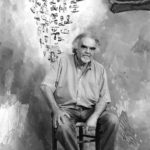Guinovart, Josep

Painter, drawer, engraver, tapestry architect, illustrator, muralist, creator of installations and sculptor, born in Barcelona in 1927.
At the age of 14 Josep Guinovart began to work as a wall painter and then studied at La Llotja School of Arts. In 1948 he held his first exhibition at Galeries Syra in Barcelona, while in 1951 he decided to dedicate his life to painting. One year later, after having contacted the group Dau al Set, he obtained a scholarship to study in Paris. Upon his return, he worked on several commissions, including, murals, decorations, figures for plays, illustrations and poster designs.
In 1976 he became an engraver, making different lithographs and etchings for the editorial Polígrafa of Barcelona.
After his first exhibition in Barcelona, his works appeared in various other exhibitions in Madrid, Palma de Mallorca, Valencia, Paris, New York, Basilea and Chicago. While he personally participated in salons, the Hispanoamerican Biennale, the Venice Biennale and other international meetings of avant-garde art. In addition, his work was greatly awarded with prizes such as the National Prize of the Arts in 1982, the Prize in Visual Arts of the Generalitat de Catalunya in 1990 or the Order of Arts and Letters of France in 1997.
Guinovart's work was influenced by figurative, surrealist and cubist styles. This is evident in his paintings Sorpresa (1951) and Familia (1952) for example. However, abstraction and informalism had occassional appearances in his work, incorporating complete resources and the manipulation of matter and object. He initated a series of experiences based on burned wooden structures, drums, waste objects, boxes, polychrome facings, signs, material formations, etc., which created a dialogue between the plastic and subjective expressions of the artist, his living environment, his symbols, ghosts and contradictions.